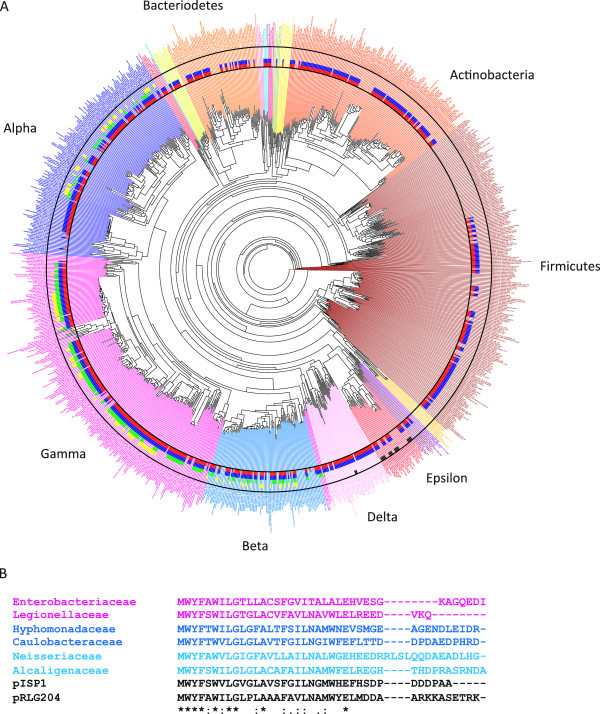Figure 6.

Distribution of cydA, cydB , cydX and other cyd -related small proteins throughout bacteria. (A) Phylogenetic tree of 1095 species from major Eubacterial clades overlaid with the presence of the different cyd genes in each species. Gene identification in a bacterial genome are labeled as follows: species adjacent to a red bar contain at least one cydA gene, to a blue bar contain at least one cydB gene, to a green bar contain at least one cydX gene, those adjacent to an yellow bar contain at least one cydZ gene, and those adjacent to a black bar contain at least one cydY gene. Major bacterial clades are labeled. The Alpha, Beta, Epsilon, Delta and Gamma labels identify the different classes in the Proteobacteria phylum. (B) Alignment of representative homologues identified from major bacterial clades. Gene names and sequences are shaded corresponding to the color used for that clade in the preceding phylogeny, while pISP1 and pRLG204 are not colored because they are not represented in the tree. Species are as follows: Shigella flexneri 2a str. 2457 T (“Enterobacteriaceae”), Legionella pneumonophila 2300/99 Alcoy (“Legionellaceae”), Hyphomonas neptunium ATCC15444 (“Hyphomonadaceae”), Asticcacaulis excentricus CB 48 (“Caulobacteraceae”), Laribacter hongkongensis HLHK9 (“Neisseriaceae”), Archromobacter xylosoxidans A8 (“Alcaligenaceae”), Mariprofundus ferrooxydans PV-1 1099921033905 (Mariprofundaceae), Sphingomonas sp. MM-1 plasmid pISP1 (“pISP1”), and Rhizonbium leguminosarum bs. trifolii WSM2304 plasmid pRLG204 (“pRLG204”). Alignments were generated using the program MUSCLE [57]. ‘*’ indicates that the residues are identical in all sequences and ‘:’ and ‘.’, respectively, indicated conserved and semi-conserved substitutions as defined by MUSCLE.
